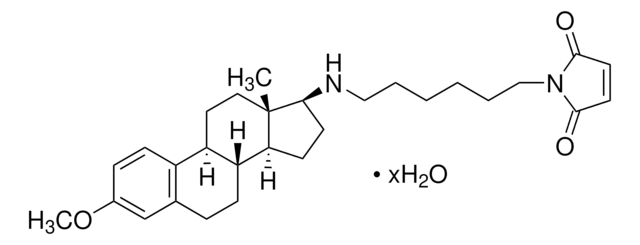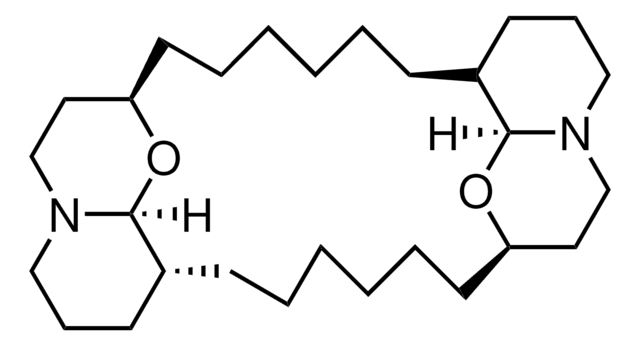100065
2-APB
≥97% (titration), crystalline solid, Ins(1,4,5)P3-induced Ca2+ release inhibitor, Calbiochem®
Sinónimos:
2-APB, 2-Aminoethoxydiphenylborate, (2-Aminoethoxy)diphenylborane
About This Item
Productos recomendados
product name
2-APB, A cell-permeable modulator of Ins(1,4,5)P3-induced Ca2+ release.
Quality Level
assay
≥97% (titration)
form
crystalline solid
manufacturer/tradename
Calbiochem®
storage condition
OK to freeze
desiccated (hygroscopic)
color
white
solubility
DMSO: 20 mg/mL
95% ethanol: 25 mg/mL
shipped in
ambient
storage temp.
2-8°C
InChI
1S/C14H16BNO/c16-11-12-17-15(13-7-3-1-4-8-13)14-9-5-2-6-10-14/h1-10H,11-12,16H2
InChI key
BLZVCIGGICSWIG-UHFFFAOYSA-N
General description
Biochem/physiol Actions
Ins(1,4,5)P3-induced Ca2+ release
Packaging
Warning
Reconstitution
Other Notes
Gregory, R.B., et al. 2001. Biochem. J.354, 285.
Ma, H.T., et al. 2001. J. Biol. Chem.276, 18888.
Ascher-Landsberg, S., et al. 1999. Biochem. Biophys. Res. Commun.264, 979.
Maruyama, T., et al. 1997. J. Biochem.122, 498.
Legal Information
signalword
Warning
hcodes
Hazard Classifications
Eye Irrit. 2 - Skin Irrit. 2 - STOT SE 3
target_organs
Respiratory system
Storage Class
11 - Combustible Solids
wgk_germany
WGK 3
flash_point_f
Not applicable
flash_point_c
Not applicable
Certificados de análisis (COA)
Busque Certificados de análisis (COA) introduciendo el número de lote del producto. Los números de lote se encuentran en la etiqueta del producto después de las palabras «Lot» o «Batch»
¿Ya tiene este producto?
Encuentre la documentación para los productos que ha comprado recientemente en la Biblioteca de documentos.
Los clientes también vieron
Nuestro equipo de científicos tiene experiencia en todas las áreas de investigación: Ciencias de la vida, Ciencia de los materiales, Síntesis química, Cromatografía, Analítica y muchas otras.
Póngase en contacto con el Servicio técnico










